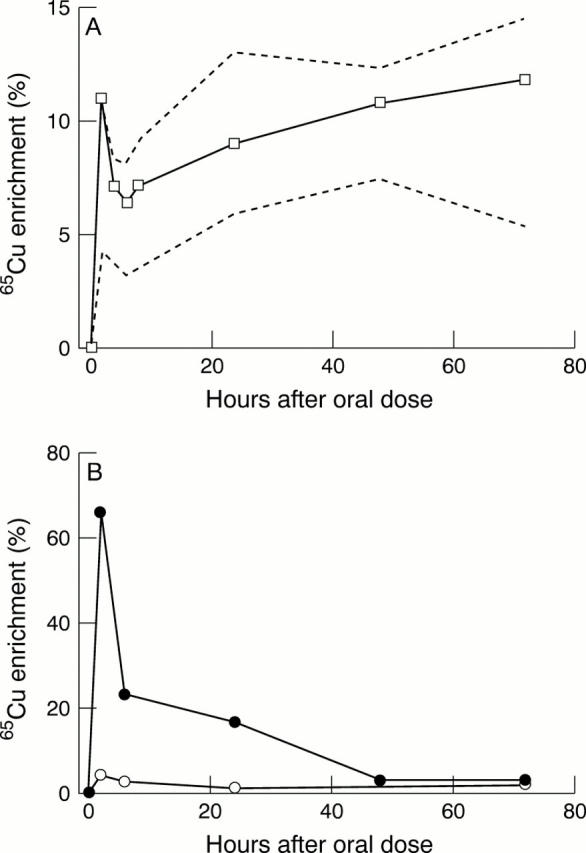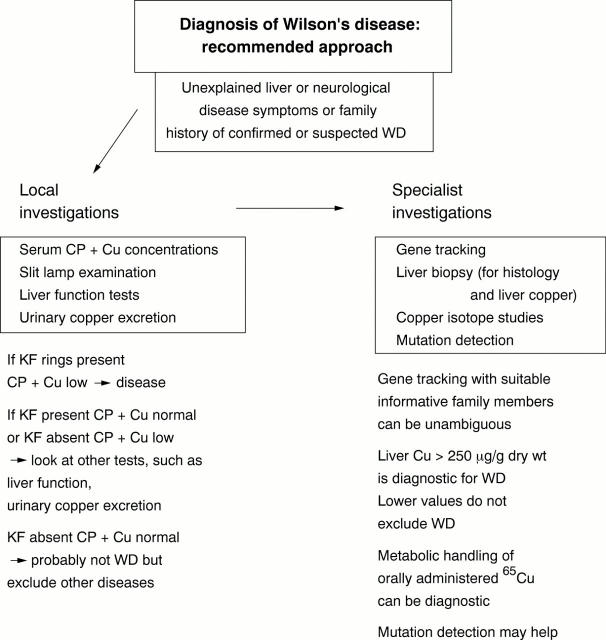Abstract
Wilson's disease, the most common inherited disorder of copper metabolism, is a recessive genetic condition. The clinical presentation of Wilson's disease is very variable. It is characterised by low serum copper and caeruloplasmin concentrations coupled with the pathological accumulation of copper in the tissues. However, there are diagnostic difficulties and these are discussed. The current value of DNA diagnosis, both in gene tracking in families or as applied to de novo cases, is examined. Wilson's disease can be treated successfully but treatment must be life long. Patients are best treated by specialist centres with experience and expertise in the condition.
Key Words: Wilson's disease • copper • diagnosis
Full Text
The Full Text of this article is available as a PDF (151.6 KB).
Figure 1 Diagnosis of Wilson's disease (WD). CP + Cu, caeruloplasmin and copper concentrations; KF, Kayser-Fleischer rings.

Figure 2 (A) Mean 65Cu enrichment time curve for serum after an oral dose of 65Cu in healthy control subjects. The broken lines give the upper and lower bounds. (B) 65Cu enrichment time curves for patients with Wilson's disease treated with penicillamine (filled circles) or with zinc (open circles). Note the difference in scale from panel (A).30
Selected References
These references are in PubMed. This may not be the complete list of references from this article.
- Brewer G. J. Practical recommendations and new therapies for Wilson's disease. Drugs. 1995 Aug;50(2):240–249. doi: 10.2165/00003495-199550020-00004. [DOI] [PubMed] [Google Scholar]
- Bull P. C., Thomas G. R., Rommens J. M., Forbes J. R., Cox D. W. The Wilson disease gene is a putative copper transporting P-type ATPase similar to the Menkes gene. Nat Genet. 1993 Dec;5(4):327–337. doi: 10.1038/ng1293-327. [DOI] [PubMed] [Google Scholar]
- Davis W., Chowrimootoo G. F., Seymour C. A. Defective biliary copper excretion in Wilson's disease: the role of caeruloplasmin. Eur J Clin Invest. 1996 Oct;26(10):893–901. doi: 10.1111/j.1365-2362.1996.tb02135.x. [DOI] [PubMed] [Google Scholar]
- Faa G., Nurchi V., Demelia L., Ambu R., Parodo G., Congiu T., Sciot R., Van Eyken P., Silvagni R., Crisponi G. Uneven hepatic copper distribution in Wilson's disease. J Hepatol. 1995 Mar;22(3):303–308. doi: 10.1016/0168-8278(95)80283-5. [DOI] [PubMed] [Google Scholar]
- Frydman M., Bonné-Tamir B., Farrer L. A., Conneally P. M., Magazanik A., Ashbel S., Goldwitch Z. Assignment of the gene for Wilson disease to chromosome 13: linkage to the esterase D locus. Proc Natl Acad Sci U S A. 1985 Mar;82(6):1819–1821. doi: 10.1073/pnas.82.6.1819. [DOI] [PMC free article] [PubMed] [Google Scholar]
- Gaffney D., Walker J. L., O'Donnell J. G., Fell G. S., O'Neill K. F., Park R. H., Russell R. I. DNA-based presymptomatic diagnosis of Wilson disease. J Inherit Metab Dis. 1992;15(2):161–170. doi: 10.1007/BF01799625. [DOI] [PubMed] [Google Scholar]
- Gollan J. L., Gollan T. J. Wilson disease in 1998: genetic, diagnostic and therapeutic aspects. J Hepatol. 1998;28 (Suppl 1):28–36. doi: 10.1016/s0168-8278(98)80373-5. [DOI] [PubMed] [Google Scholar]
- Huang C. C., Chu N. S. Wilson's disease: resolution of MRI lesions following long-term oral zinc therapy. Acta Neurol Scand. 1996 Feb-Mar;93(2-3):215–218. doi: 10.1111/j.1600-0404.1996.tb00203.x. [DOI] [PubMed] [Google Scholar]
- Loudianos G., Dessì V., Lovicu M., Angius A., Nurchi A., Sturniolo G. C., Marcellini M., Zancan L., Bragetti P., Akar N. Further delineation of the molecular pathology of Wilson disease in the Mediterranean population. Hum Mutat. 1998;12(2):89–94. doi: 10.1002/(SICI)1098-1004(1998)12:2<89::AID-HUMU3>3.0.CO;2-G. [DOI] [PubMed] [Google Scholar]
- Loudianos G., Figus A. L., Loi A., Angius A., Dessì V., Deiana M., De Virgiliis S., Monni G., Cao A., Pirastu M. Improvement of prenatal diagnosis of Wilson disease using microsatellite markers. Prenat Diagn. 1994 Oct;14(10):999–1002. doi: 10.1002/pd.1970141018. [DOI] [PubMed] [Google Scholar]
- Lyon T. D., Fell G. S., Gaffney D., McGaw B. A., Russell R. I., Park R. H., Beattie A. D., Curry G., Crofton R. J., Gunn I. Use of a stable copper isotope (65Cu) in the differential diagnosis of Wilson's disease. Clin Sci (Lond) 1995 Jun;88(6):727–732. doi: 10.1042/cs0880727. [DOI] [PubMed] [Google Scholar]
- Maier-Dobersberger T., Mannhalter C., Rack S., Granditsch G., Kaserer K., Korninger L., Steindl P., Gangl A., Ferenci P. Diagnosis of Wilson's disease in an asymptomatic sibling by DNA linkage analysis. Gastroenterology. 1995 Dec;109(6):2015–2018. doi: 10.1016/0016-5085(95)90771-8. [DOI] [PubMed] [Google Scholar]
- Martins da Costa C., Baldwin D., Portmann B., Lolin Y., Mowat A. P., Mieli-Vergani G. Value of urinary copper excretion after penicillamine challenge in the diagnosis of Wilson's disease. Hepatology. 1992 Apr;15(4):609–615. doi: 10.1002/hep.1840150410. [DOI] [PubMed] [Google Scholar]
- O'Donnell J. G., Watson I. D., Fell G. S., Allison M. E., Russell R. I., Mills P. R. Wilson's disease presenting as acute fulminant hepatic failure. Scott Med J. 1990 Aug;35(4):118–119. doi: 10.1177/003693309003500410. [DOI] [PubMed] [Google Scholar]
- Roberts E. A., Cox D. W. Wilson disease. Baillieres Clin Gastroenterol. 1998 Jun;12(2):237–256. doi: 10.1016/s0950-3528(98)90133-6. [DOI] [PubMed] [Google Scholar]
- Steindl P., Ferenci P., Dienes H. P., Grimm G., Pabinger I., Madl C., Maier-Dobersberger T., Herneth A., Dragosics B., Meryn S. Wilson's disease in patients presenting with liver disease: a diagnostic challenge. Gastroenterology. 1997 Jul;113(1):212–218. doi: 10.1016/s0016-5085(97)70097-0. [DOI] [PubMed] [Google Scholar]
- Tanzi R. E., Petrukhin K., Chernov I., Pellequer J. L., Wasco W., Ross B., Romano D. M., Parano E., Pavone L., Brzustowicz L. M. The Wilson disease gene is a copper transporting ATPase with homology to the Menkes disease gene. Nat Genet. 1993 Dec;5(4):344–350. doi: 10.1038/ng1293-344. [DOI] [PubMed] [Google Scholar]
- Thomas G. R., Bull P. C., Roberts E. A., Walshe J. M., Cox D. W. Haplotype studies in Wilson disease. Am J Hum Genet. 1994 Jan;54(1):71–78. [PMC free article] [PubMed] [Google Scholar]
- Thomas G. R., Forbes J. R., Roberts E. A., Walshe J. M., Cox D. W. The Wilson disease gene: spectrum of mutations and their consequences. Nat Genet. 1995 Feb;9(2):210–217. doi: 10.1038/ng0295-210. [DOI] [PubMed] [Google Scholar]
- Tsai C. H., Tsai F. J., Wu J. Y., Chang J. G., Lee C. C., Lin S. P., Yang C. F., Jong Y. J., Lo M. C. Mutation analysis of Wilson disease in Taiwan and description of six new mutations. Hum Mutat. 1998;12(6):370–376. doi: 10.1002/(SICI)1098-1004(1998)12:6<370::AID-HUMU2>3.0.CO;2-S. [DOI] [PubMed] [Google Scholar]
- Tu J. B., Blackwell R. Q. Studies on levels of penicillamine-induced cupriuresis in heterozygotes of Wilson's disease. Metabolism. 1967 Jun;16(6):507–513. doi: 10.1016/0026-0495(67)90079-0. [DOI] [PubMed] [Google Scholar]
- Walshe J. M., Dixon A. K. Dangers of non-compliance in Wilson's disease. Lancet. 1986 Apr 12;1(8485):845–847. doi: 10.1016/s0140-6736(86)90949-9. [DOI] [PubMed] [Google Scholar]
- Walshe J. M. The discovery of the therapeutic use of D-penicillamine. J Rheumatol Suppl. 1981 Jan-Feb;7:3–8. [PubMed] [Google Scholar]
- Walshe J. M. The management of pregnancy in Wilson's disease treated with trientine. Q J Med. 1986 Jan;58(225):81–87. [PubMed] [Google Scholar]
- Yamaguchi Y., Heiny M. E., Shimizu N., Aoki T., Gitlin J. D. Expression of the Wilson disease gene is deficient in the Long-Evans Cinnamon rat. Biochem J. 1994 Jul 1;301(Pt 1):1–4. doi: 10.1042/bj3010001. [DOI] [PMC free article] [PubMed] [Google Scholar]



